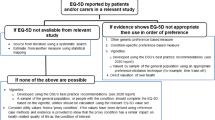Abstract
The quality-adjusted life-year (QALY) is an international standard in cost-effectiveness analysis. A known concern arises from the relatively lower QALY gains attributed to treatments that extend the life of individuals with chronic disability. We analyze here the advantages and disadvantages of the equal value life-year (evLY) as an alternative or a complementary measure to the QALY, and share learned experiences from using this measure in health technology assessments. We present the conceptual rationale for the evLY, describe how it is estimated, and assess the differences in results between analyses based on the evLY and the QALY. We share a how-to guide in estimating the evLY using a downloadable tool and summarize our empirical experience using this measure. Incremental evLYs are feasible and address concerns regarding the risk for a cost-effectiveness analysis to undervalue treatments for people with chronic disabilities. Based on our set of analyses using the evLY, a threshold of $84,000 per evLY gained would be needed to maintain alignment with a threshold of $100,000 per added QALY. The evLY is a measure of health gain that can be used as an alternative or a complement to the QALY to address concerns related to undervaluing treatments that extend the life of individuals with serious illness or chronic disability. We recommend that it be reported within all cost-effectiveness analyses but may have special relevance in the current political environment in the USA, where use of the QALY is often challenged or prohibited.



Similar content being viewed by others
References
Garrison LP Jr, Neumann PJ, Willke RJ, et al. A health economics approach to US value assessment frameworks: summary and recommendations of the ISPOR Special Task Force report [7]. Value Health. 2018;21:161–5.
Sanders GD, Neumann PJ, Basu A, et al. Recommendations for conduct, methodological practices, and reporting of cost-effectiveness analyses: second panel on cost-effectiveness in health and medicine. JAMA. 2016;316:1093–103.
Rand LZ, Kesselheim AS. Controversy over using quality-adjusted life-years in cost-effectiveness analyses: a systematic literature review. Health Aff (Millwood). 2021;40:1402–10.
Ubel PA, Nord E, Gold M, et al. Improving value measurement in cost-effectiveness analysis. Med Care. 2000;38:892–901.
National Council on Disability. Quality-adjusted life years and the devaluation of life with disability. Available from: https://ncd.gov/sites/default/files/NCD_Quality_Adjusted_Life_Report_508.pdf. Accessed 15 Apr 2023.
Centers for Medicare & Medicaid Services. Medicare drug price negotiation program initial guidance. Available from: https://www.cms.gov/files/document/medicare-drug-price-negotiation-program-initial-guidance.pdf. Accessed 10 Apr 2023.
PPACA. Sec. 6301\1182 SSA. Page 678. Available from: http://housedocs.house.gov/energycommerce/ppacacon.pdf. Accessed 3 Jan 2023.
Carlson JJ, Brouwer ED, Kim E, et al. Alternative approaches to quality-adjusted life-year estimation within standard cost-effectiveness models: literature review, feasibility assessment, and impact evaluation. Value Health. 2020;23:1523–33.
Beresniak A, Dupont D. Is there an alternative to quality-adjusted life years for supporting healthcare decision making? Expert Rev Pharmacoecon Outcomes Res. 2016;16:351–7.
Nord E. Beyond QALYs: multi-criteria based estimation of maximum willingness to pay for health technologies. Eur J Health Econ. 2018;19:267–75.
Nord E, Johansen R. Concerns for severity in priority setting in health care: a review of trade-off data in preference studies and implications for societal willingness to pay for a QALY. Health Policy. 2014;116:281–8.
Nord E, Pinto JL, Richardson J, et al. Incorporating societal concerns for fairness in numerical valuations of health programmes. Health Econ. 1999;8:25–39.
ICER. Cost-effectiveness, the QALY, and the evLYG. Available from: https://icer.org/our-approach/methods-process/cost-effectiveness-the-qaly-and-the-evlyg/. Accessed 3 Jan 2023.
Jiang R, Janssen MFB, Pickard AS. US population norms for the EQ-5D-5L and comparison of norms from face-to-face and online samples. Qual Life Res. 2021;30:803–16.
Paulden M. Are the ‘equal value of life years gained’ and ‘health years in total’ approaches viable alternatives to the QALY? Matters of logic and matters of value. Medical Decision Making 2020 Meeting. Available from: https://www.youtube.com/watch?v=MtNKI2VfTJw. Accessed 3 Jan 2023.
Basu A, Carlson J, Veenstra D. Health years in total: a new health objective function for cost-effectiveness analysis. Value Health. 2020;23:96–103.
Zamora B, Garrison LP, Unuigbe A, et al. Reconciling ACEA and MCDA: is there a way forward for measuring cost-effectiveness in the US healthcare setting? Cost Eff Resour Alloc. 2021;19:13.
National Council on Disability. Policy brief: alternatives to QALY-based cost-effectiveness analysis for determining the value of prescription drugs and other health interventions. Available from: https://www.ncd.gov/sites/default/files/NCD_Alternatives_to_the_QALY_508.pdf. Accessed 3 Jan 2023.
Rand LZ, Melendez-Torres GJ, Kesselheim AS. Alternatives to the quality-adjusted life year: how well do they address common criticisms? Health Serv Res. 2023;58:433–44.
Acknowledgements
The authors acknowledge Marina Richardson for analytic support included within this article.
Author information
Authors and Affiliations
Corresponding author
Ethics declarations
Funding
All authors were employees of The Institute for Clinical and Economic Review (ICER) during the contributions made to this manuscript. The research represented within this article is not grant funded, but is aligned with ICER’s work. Please see the ICER’s website for information on funding that supports the salaries of all ICER employees.
Conflict of interest
Jonathan D. Campbell, Melanie D. Whittington, and Steven D. Pearson have no conflicts of interest that are directly relevant to the content of this article.
Consent to participate
Not applicable.
Consent for publication
Not applicable.
Availability of data and material
This article has data included as Electronic Supplementary Material
Code availability
The source code is included as Electronic Supplementary Material.
Author contributions
All authors meet the International Committee for Medical Journal Editors authorship criteria. All authors have read and approved the final version of this manuscript.
Supplementary Information
Below is the link to the electronic supplementary material.
Rights and permissions
Springer Nature or its licensor (e.g. a society or other partner) holds exclusive rights to this article under a publishing agreement with the author(s) or other rightsholder(s); author self-archiving of the accepted manuscript version of this article is solely governed by the terms of such publishing agreement and applicable law.
About this article
Cite this article
Campbell, J.D., Whittington, M.D. & Pearson, S.D. An Alternative Measure of Health for Value Assessment: The Equal Value Life-Year. PharmacoEconomics 41, 1175–1182 (2023). https://doi.org/10.1007/s40273-023-01302-6
Accepted:
Published:
Issue Date:
DOI: https://doi.org/10.1007/s40273-023-01302-6




